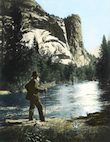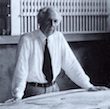

 The call to live in harmony with nature is a plea of green pioneers throughout history such as Henry David Thoreau, John Muir, and Frank Lloyd Wright.
The call to live in harmony with nature is a plea of green pioneers throughout history such as Henry David Thoreau, John Muir, and Frank Lloyd Wright.
Ecopsychology began in the company of these good men. They worked politically, practically and poetically in service of the sanity, sustainability and social connectivity that comes from traversing the liminal space between the city and the wilderness.
Architect Frank Lloyd Wright critiqued the polarization of humans and nature that was created, as he saw it, by groups of people – city dwellers – who had given over their individuality to the collective, to urbanization, including its architectural box-buildings. His response was “organic architecture,” a term he discusses in a 1958 interview with WTTW-Chicago television’s William MacDonald: “…the new idea was to eliminate the box and let everything that was in go outward and associate with its environment. So environment and interior and life itself became as one.”
Wright left a legacy of buildings that blend and relate with their natural surroundings, both in design and the elements used to build them. He prioritized the life inside and outside of the structure, and used the structure to enhance that relationship, to make the landscape part of the room. “… The site is all important and your sympathetic appreciation of the site and understanding of it as it appears in the building is a measure of your success as an architect, more or less.” Famous examples of this are the “Fallingwater” Residence in Mill Run, Pennsylvania, Wright’s Taliesen West residence in Scottsdale, Arizona, and the Marin County Civic Center in San Rafael, California. “It seems that the geometry and the rhythm (interior rhythm) of nature manifest themselves in these various poetic forms that we see in the flowers, and trees, and everywhere as a matter of fact.”
Like Wright, and nearly a century earlier, Henry David Thoreau lived by principles rather than precedence, and these principles were derived from the land itself. He too was critical of the culture that ignored fundamentals: “When I think of acquiring for myself one of our luxurious dwellings, I am deterred, for, so to speak, the country is not yet adapted to human culture, and we are still forced to cut our spiritual bread far thinner than our forefathers did their wheaten.”
This statement introduces Thoreau’s account of a period in which he lived a rather solitary lifestyle on the edge of town for two years and two months in Concord, Massachusetts, titled Walden; or, A Life in the Woods. The writer became so attuned to the pond and its surroundings that he spends pages recounting the minute changes in weather and foliage from day to day. How often do we take time to notice the complex simplicity of changing light across a body of water? “A lake is the landscape’s most beautiful and expressive feature. It is earth’s eye; looking into which the beholder measures the dept of his own nature. The fluviatile trees next the shore are the slender eyelashes which fringe it, and the wooded hills and cliffs around are its overhanging brows.”
As he gets to know his gentle surroundings, he sees them as living beings. This recognition that the land is alive – a basic pretext of contemporary ecopsychology – is an essential mode of consciousness for poets and those who work the land, and can be for the rest of us as well. Moreover, Thoreau’s insistence on self-reliance is a wake-up call for those lulled into the comfort of social group-think.
The benefits of social organization can also be culled for good use, as with John Muir’s advocacy on behalf of California’s natural wonders. While Thoreau experienced and documented the subtle changes in one location, Muir was an avid traveler and adventurer, experiencing nature on a grand level by trekking through it. He too wrote exquisite accounts of the land formations, especially in the Yosemite Valley, and his essay on “The Treasures of Yosemite,” printed in Century Magazine, brought to life for the American public the power and magnificence of the high country, Cathedral Rocks, Yosemite Falls, Mirror Lake, Half Dome and the Liberty Cap. “But no temple made with hands can compare with Yosemite. Every rock in its walls seems to glow with life. Some lean back in majestic repose; others, absolutely sheer or nearly so for thousands of feet, advance beyond their companions in thoughtful attitudes, giving welcome to storms and calms alike, seemingly conscious, yet heedless of everything going on about them.”
He goes on to describe the streams and the yellow light formed by slanting sunbeams. Muir’s exquisite writings and sketches are interspersed with the call for sustainability: “Wilderness is a necessity, mountain parks and reservations are useful not only as fountains of timber and irrigating rivers, but as fountains of life…where nature may heal and cheer and give strength to body and soul alike.” John Muir’s publication was followed two months later by the creation in 1890 of the U.S. National Parks system by President Harrison. Muir’s words resound yet today as we contend with the devastation of fragile and diverse ecosystems on a massive scale. “Were the importance of our forests at all understood by the people in general, even from an economic standpoint, their preservation would call forth the most watchful attention of the Government. At present, however, every kind of destruction is moving on with accelerated speed.”
These three men worked in different ways to bridge the divide between the natural places they love and the society who has not yet gained their full appreciation. Insodoing they built a foundation for addressing the urban alienation which is at ther root of collective irresponsibility towards the earth- not just where we build, but also how we determine our place within the environment of this planet, starting by acknowledging that we are part of it and that it is, we are, living and sentient.
Resources and further reading:
Thoreau Center for Sustainability
The Frank Lloyd Wright Foundation
John Muir Quotes


